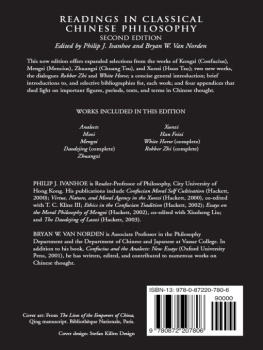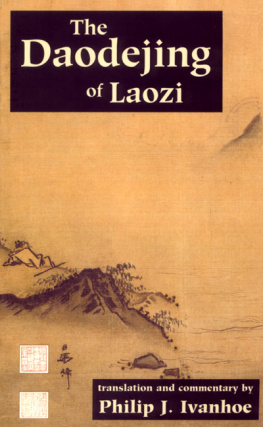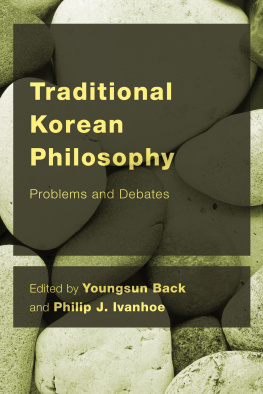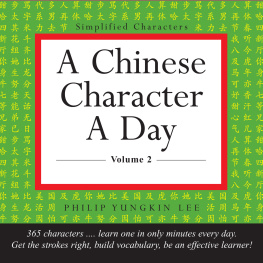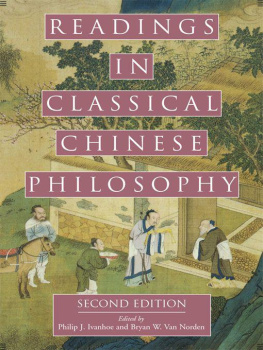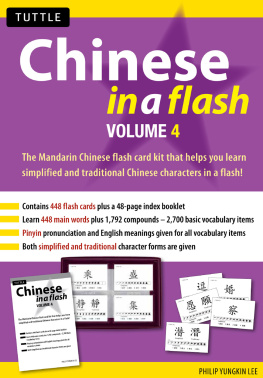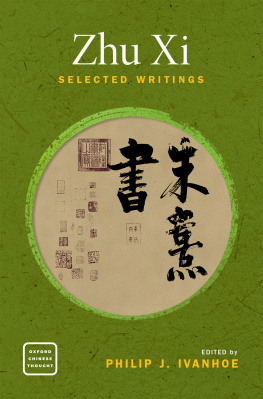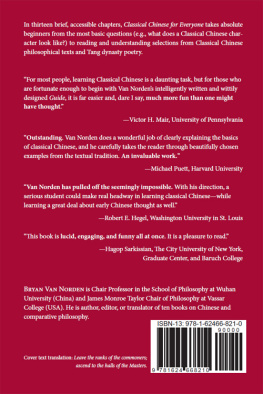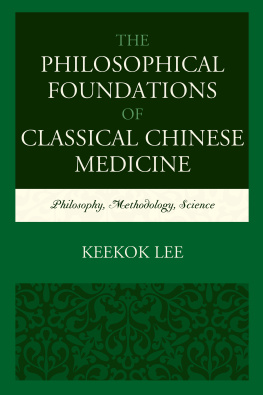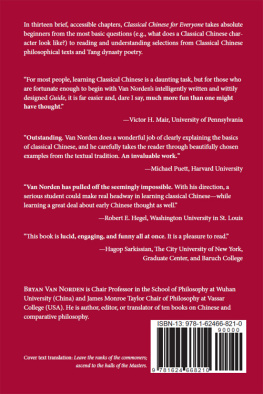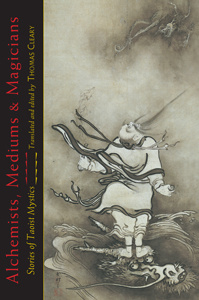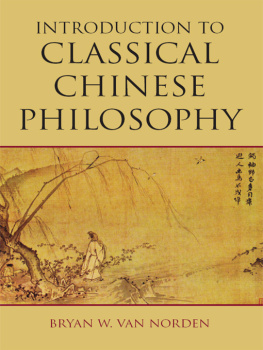Ivanhoe Philip J. - Readings in Classical Chinese Philosophy
Here you can read online Ivanhoe Philip J. - Readings in Classical Chinese Philosophy full text of the book (entire story) in english for free. Download pdf and epub, get meaning, cover and reviews about this ebook. City: China;Indianapolis, year: 2007, publisher: Hackett Publishing Company, Inc., genre: Romance novel. Description of the work, (preface) as well as reviews are available. Best literature library LitArk.com created for fans of good reading and offers a wide selection of genres:
Romance novel
Science fiction
Adventure
Detective
Science
History
Home and family
Prose
Art
Politics
Computer
Non-fiction
Religion
Business
Children
Humor
Choose a favorite category and find really read worthwhile books. Enjoy immersion in the world of imagination, feel the emotions of the characters or learn something new for yourself, make an fascinating discovery.
- Book:Readings in Classical Chinese Philosophy
- Author:
- Publisher:Hackett Publishing Company, Inc.
- Genre:
- Year:2007
- City:China;Indianapolis
- Rating:4 / 5
- Favourites:Add to favourites
- Your mark:
- 80
- 1
- 2
- 3
- 4
- 5
Readings in Classical Chinese Philosophy: summary, description and annotation
We offer to read an annotation, description, summary or preface (depends on what the author of the book "Readings in Classical Chinese Philosophy" wrote himself). If you haven't found the necessary information about the book — write in the comments, we will try to find it.
Readings in Classical Chinese Philosophy — read online for free the complete book (whole text) full work
Below is the text of the book, divided by pages. System saving the place of the last page read, allows you to conveniently read the book "Readings in Classical Chinese Philosophy" online for free, without having to search again every time where you left off. Put a bookmark, and you can go to the page where you finished reading at any time.
Font size:
Interval:
Bookmark:
READINGS IN CLASSICAL CHINESE PHILOSOPHY
READINGS IN CLASSICAL CHINESE PHILOSOPHY
Second Edition
Edited by
Philip J. Ivanhoe
City University of Hong Kong
and
Bryan W. Van Norden
Vassar College
Hackett Publishing Company, Inc.
Indianapolis/Cambridge
Copyright 2001
Reprinted in 2003 by Hackett Publishing Company, Inc.
Second edition copyright 2005 by Hackett Publishing Company, Inc.
All rights reserved
Printed in the United States of America
12 11 10 09 08 07 2 3 4 5 6 7 8
For further information, please address
Hackett Publishing Company, Inc.
P.O. Box 44937
Indianapolis, Indiana 46244-0937
www.hackettpublishing.com
Composition by SNP Best-set Typesetter Ltd., Hong Kong
Printed at Malloy, Inc.
Library of Congress Cataloging-in-Publication Data
Readings in classical Chinese philosophy/edited by Philip J. Ivanhoe and Bryan W. Van Norden.2nd ed.
p. cm.
Includes bibliographical references.
ISBN 0-87220-781-1 (cloth)ISBN 0-87220-780-3 (pbk.)
1. Philosophy, ChineseTo 221 B.C. I. Ivanhoe, P. J. II. Van Norden, Bryan W. (Bryan William)
B126.R43 2005
181.11dc22 2005050463
ISBN-13: 978-0-87220-781-3 (cloth)
ISBN-13: 978-0-87220-780-6 (pbk.)
epub ISBN: 978-1-60384-520-5
 CONTENTS
CONTENTS 
This newly revised edition of Readings in Classical Chinese Philosophy introduces the seven most familiar, widely read, and important thinkers of the classical period (roughly the sixth to the end of the third century B.C.E.) of Chinese philosophy, as well as two critically important but often neglected philosophers of this period: Gongsun Longzi and Yang Zhu. Each of the seven chapters and two Supplemental Text sections of the volume begins with a brief introduction to the work and thinker it concerns and concludes with a short and lightly annotated selective bibliography. The volume is intended to serve as an introduction to and source book for these texts and not as a philosophical primer for the thought of these authors. Introductory and interpretive material is kept to a minimum, but the volume includes four appendicesImportant Figures, Important Periods, Important Texts, and Important Termsthat describe mythical and historical figures, periods of time, classical texts, and specialized terms that regularly appear in the texts translated here. There is also a Map of China during the Spring and Autumn Period, which shows the approximate locations of the major states and rivers. Readers are encouraged to turn to these reference materials whenever they encounter terms or names in the text that are not explained in footnotes. Explanatory notes are provided at the bottom of each page in cases of a single occurrence of an obscure term or name or when more explanation appeared to be warranted. Those who wish to pursue additional secondary literature in English concerning the texts and thinkers included in this reader are encouraged to consult the Title Web Site link that is maintained in support of this volume at www.hackettpublishing.com.
Knowledge of the Chinese language is not in any way required for making full and thorough use of this volume. However, Chinese characters are provided for important references and terms of philosophical art in order to help the beginning student of Chinese and for the common edification of all. We do not provide characters for textual emendations or other textual notes, as these issues require advanced facility in the classical Chinese language and other basic research languages of sinology. Readers interested in pursuing textual issues are encouraged to consult the appropriate sections of the web page mentioned above.
We have used the Pinyin romanization system throughout this volume, although we have chosen to romanize the common formal names of Chinese thinkerstheir surnames and the honorific title zi (literally Master)as one word rather than two. So, for example, Zhuang Zi (literally Master Zhuang) is written as Zhuangzi and Han Fei Zi (Master Han Fei) appears as Han Feizi. All romanizations in the bibliographies and notes remain in their original form in order to facilitate locating these sources. We have provided a complete table comparing the Pinyin and older Wade-Giles systems of romanization following this Preface.
(literally Master)as one word rather than two. So, for example, Zhuang Zi (literally Master Zhuang) is written as Zhuangzi and Han Fei Zi (Master Han Fei) appears as Han Feizi. All romanizations in the bibliographies and notes remain in their original form in order to facilitate locating these sources. We have provided a complete table comparing the Pinyin and older Wade-Giles systems of romanization following this Preface.
We, the editors, have tried to balance a desire for consistency in the use of specialized terms with the variety of senses many of these terms have within the range of texts presented here, as well as with the different sensibilities and styles of the individual translators. In cases where a certain important term of art is rendered in different ways, we have provided notes alerting readers and directing their attention to the other occurrences and translations.
We would like to thank the contributors to this volume for their work and their patience with us throughout the editorial process. Edward G. Ted Slingerland III, a member of the Department of Asian Studies at the University of British Columbia, translated The Analects of Kongzi (Confucius); Paul Kjellberg, Chair of the Philosophy Department at Whittier College, contributed the selections from the Zhuangzi and on the thought of Yang Zhu; Eric L. Hutton, a member of the Philosophy Department of University of Utah, translated parts of the Xunzi; and Joel Sahleen, from the Department of Asian Languages at Stanford University, contributed selections from the Han Feizi. We, the editors, contributed the remaining translations of the Mozi, Mengzi (Mencius), and Laozi (The Daodejing), as well as the selections representing the thought of Gongsun Longzi.
We would like to thank Robert B. Rama and Jeremy R. Robinson for their help in preparing the manuscript for this volume. Denin Lee provided invaluable assistance in locating and helping to reproduce the illustrations of individual philosophers that appear at the beginning of each chapter. Mark Csikszentmihalyi, Shari Ruei-hua Epstein, Eirik Harris, T. C. Jack Kline III, Pauline Chen Lee, Shuen-fu Lin, and Eric Schwitzgebel offered very helpful corrections and comments on various parts of earlier drafts of the manuscript.
The following conversion table is provided in order to allow the reader to keep track of and convert between the Pinyin and Wade-Giles systems of romanization.
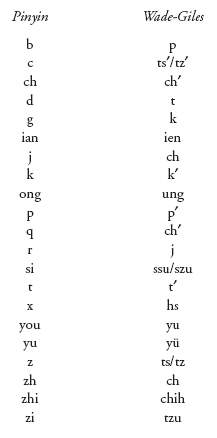

Chinese history and thought extend much farther back in time than the period covered in this volume, though it is fair to say that philosophyin the sense of self-conscious reflection upon, modification, and defense of ones viewsbegins with the debate between Kongzi and Mozi. Nevertheless, a general sense of the trajectory of Chinese thought prior to this period and some understanding of the shape of the intellectual landscape on the eve of the age represented here will help the reader to appreciate more deeply the views of the thinkers presented.
The earliest substantial written documents we have from China are carved onto bone and shell or etched onto ritual vessels of bronze. These incised inscriptions, together with other modern archeological discoveries, have allowed scholars to reconstruct speculative yet intriguing pictures of very early Chinese society and culture.
Next pageFont size:
Interval:
Bookmark:
Similar books «Readings in Classical Chinese Philosophy»
Look at similar books to Readings in Classical Chinese Philosophy. We have selected literature similar in name and meaning in the hope of providing readers with more options to find new, interesting, not yet read works.
Discussion, reviews of the book Readings in Classical Chinese Philosophy and just readers' own opinions. Leave your comments, write what you think about the work, its meaning or the main characters. Specify what exactly you liked and what you didn't like, and why you think so.

